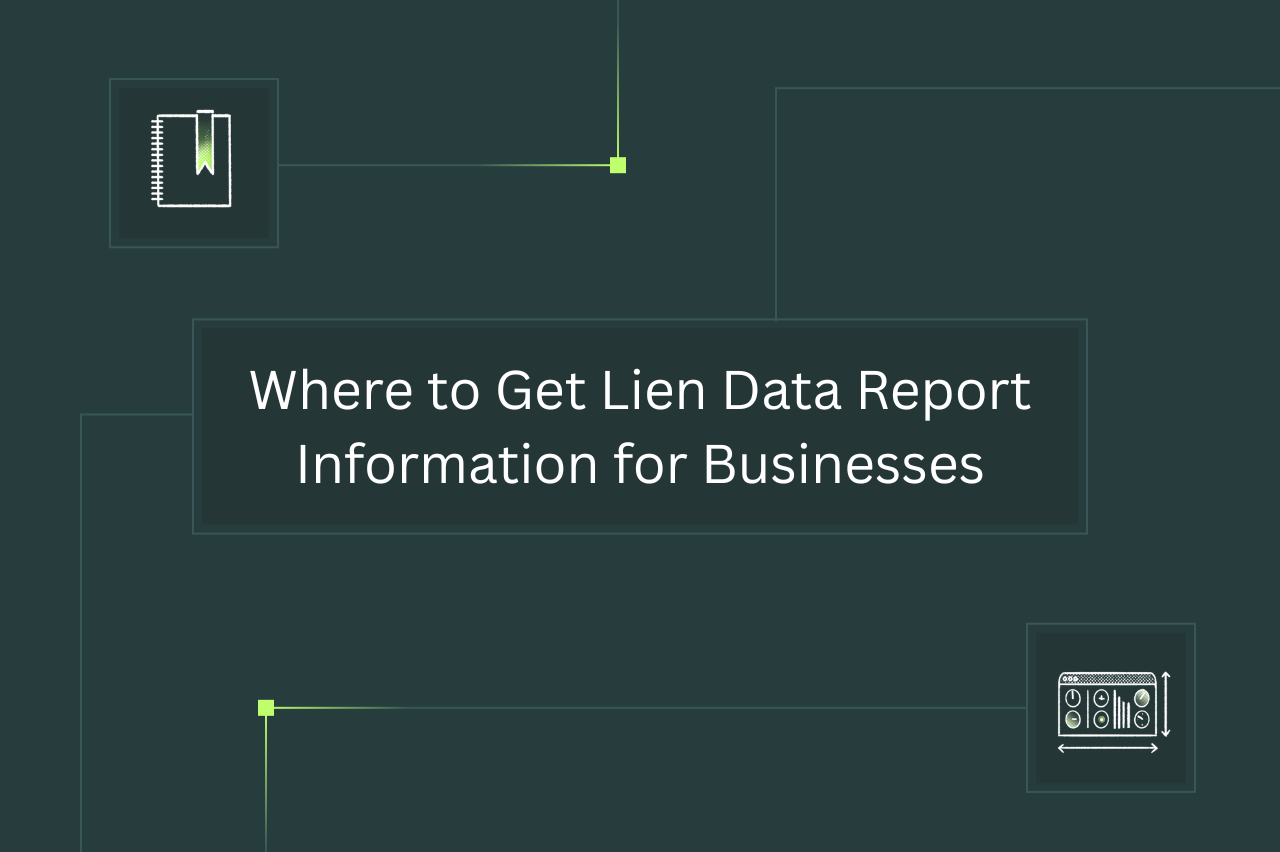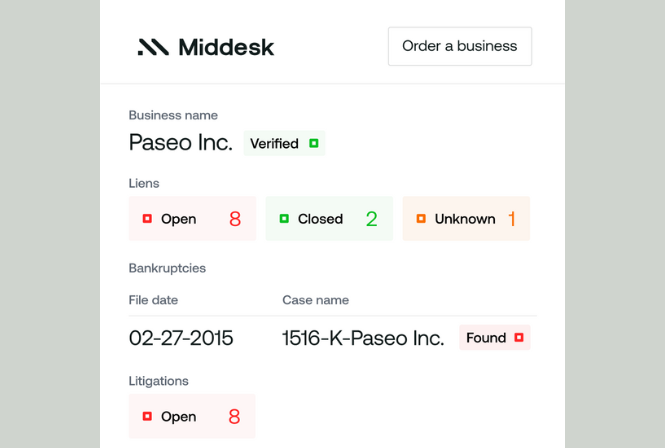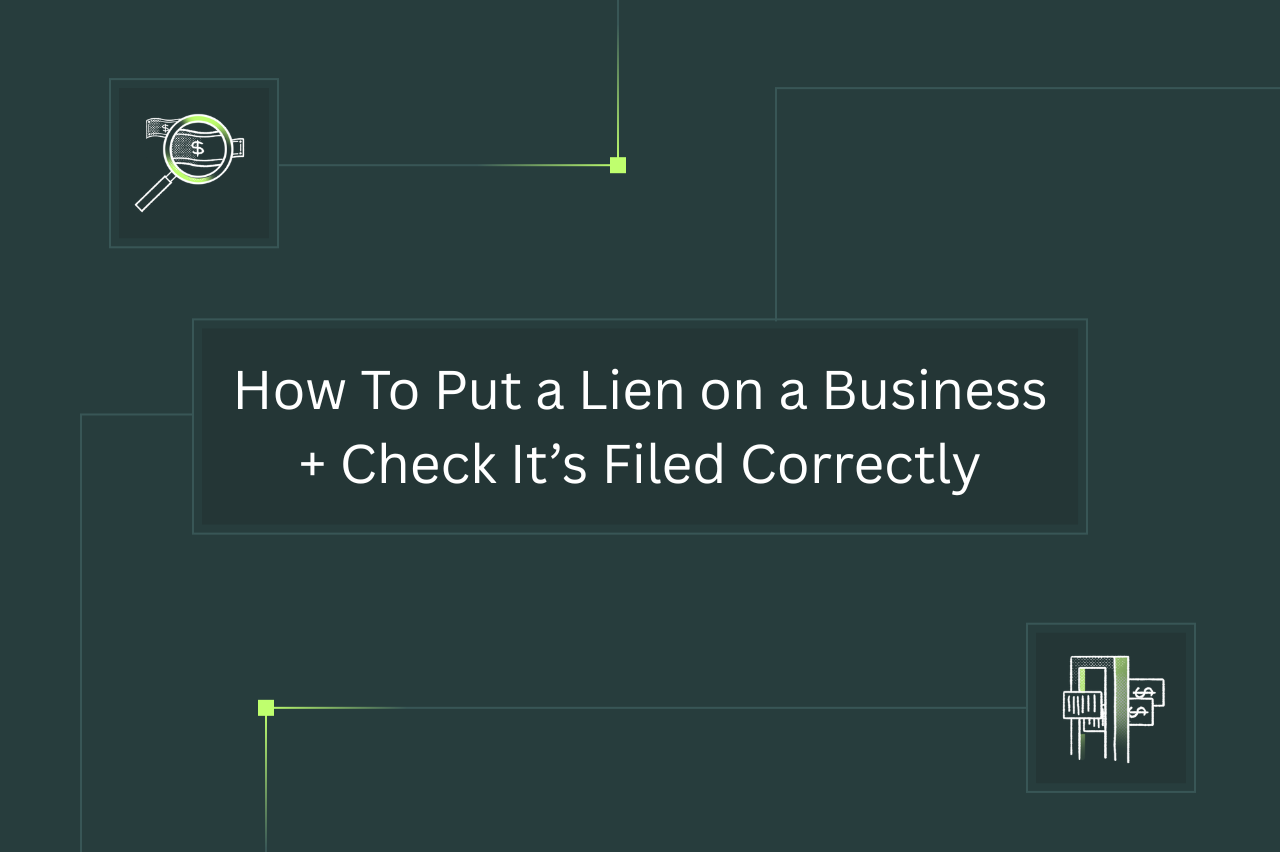In brief:
- Lien data refers to any information regarding a legal claim to an entity’s assets if they fail to pay off a debt they owe by a certain date.
- Business lien data helps organizations assess risk for a B2B relationship. It can be used to check if the other business is at risk of losing essential assets, will have difficulty securing additional funding, or generally may not be able to fulfill its obligations to the organization.
- Business lien data may be found at a Secretary of State office, or a state or county recorder’s office, depending on the state where the lien is filed. Tax liens specifically can be retrieved from the IRS by submitting a Freedom of Information Act request. A dedicated business underwriting solution like Middesk, however, can directly connect to all of these agencies at once to search for and retrieve lien data.
When running a B2B business, one thing you should know when onboarding other businesses as customers is whether those businesses have any risky debts. These are debts that can block your customers from borrowing more money or, if not repaid, can result in your customers losing assets integral to their operations. These limitations, in turn, can make your customers unable to fulfill their obligations to you.
You can find this information in a business lien data report. This gives information on legal claims to a business customer’s property or assets should it fail to pay off its debts on time. You can then consider factors like the debt amount, the claimed assets (and their value), and the deadline for paying the debt to decide if the lien is a significant enough risk factor in a B2B relationship.
In this article, we expand on what lien information a report would include. We also explain why you should look for lien data for identity verification and risk assessment purposes when onboarding a business customer. Finally, we describe some methods for getting lien data on a business.
- What is a lien data report?
- Why is lien data important for business verification?
- What is included in a lien data report?
- How & where to get a lien data report
Business lien data is important in the context of due diligence when your company wants to onboard another business as a client or partner. It’s an indication that a business may be in danger of forfeiting assets to a creditor or government because of an outstanding debt.
Those assets may, in turn, be necessary for the business to continue functioning; if, for example, those assets are equipment that’s integral to what the business does. A lien may also make it difficult for a business to get additional funding because it has less available collateral to offer.
Just because a business has one or more liens filed against it doesn’t automatically mean that it’s too high-risk. It’s important to consider the actual assets, values, and timings associated with a lien. As a few examples:
- The business’s operations may not be heavily affected if it loses the claimed assets.
- The debt may be an amount that the business can pay off quickly.
- The business may have a generous amount of time to pay off the debt.
All of these factors, when weighed against your company’s risk appetite, may allow for a B2B relationship to go ahead.
When you’re verifying these new businesses during onboarding to make data-driven decisions about who to initiate a relationship with, it’s imperative that you can get this data quickly and reliably in time to make a decision. Our webinar below can show you how to do it:
{{gated-content-block="/events/webinar-bev-break-uccliens-jun-2025"}}
A lien data report may include some or all of the following types of information about a lien:
- The lien’s type (e.g. tax, judgment, bank, mechanic, real estate, consensual, statutory)
- When the lien was filed and/or modified (i.e. adding or removing debtors or assets)
- The names and contact information of debtors
- The names and contact information of secured parties (i.e. who the debt is owed to)
- Descriptive information about the collateral (e.g. value, type, quantity)
- The lien’s expiration date
- The lien’s registering agent
How can you find lien data on a business your company wants to onboard? There are a few different methods, but also some complications that may warrant choosing one method over another. We’ll explain in the next section.
If you want to see it first-hand instead, check our our on-demand product demo of Middesk Credit Assessment:
{{gated-content-block="/events/productdemo-creditassessment-august-2025"}}
Lien data in the U.S. can sometimes be tricky to find for a business because where a lien is filed may depend on a number of factors. It can be determined by where either the debtor or the secured party is located. This, in turn, can hinge on whether each party is named in the lien as an individual person or as a business. Alternatively, the lien could be filed where the actual assets claimed in the lien are located.
It's also challenging because a lien can be recorded at the state or county level. If recorded at the county level, a lien report can be more difficult to find, as the specific county it’s recorded in can depend on the factors listed above.
With that, here are some options for finding information on business liens:
1. Use Middesk to search multiple data sources simultaneously
Middesk has direct relationships with first-party sources of business information, including Secretary of State offices, the IRS, and county recorder’s offices. Using our Business Verification solution and Business Underwriting tools, you can quickly search all of these places at once and retrieve the most up-to-date lien data on a business.
At the same time, you can also pull other information useful for verifying the identity of a business and assessing the risk of a B2B relationship with it. This includes registration information and documents, tax IDs, watchlist screenings, litigations, and more.
2. Search at a Secretary of State office
You can also manually search individual Secretary of State offices for lien reports. You can use a SoS office’s online portal, or fill out a UC-11 form and send it in.
This isn’t the most efficient option, however. Each SoS’s online portal works a bit differently in terms of its overall interface, whether you have to register for an account, and whether you have to pay to conduct a search. Also, finding relevant information at any given SoS office isn’t a guarantee, as a lien may have been recorded in a specific county or even another state entirely.
With Middesk, you only have to search a company once, receiving an instant result. And since we get data directly from SOS offices, you can trust that our results are just as accurate and up-to-date as searching each individual SOS office manually.
{{related-content-block="/blog/automatically-retrieve-documents-from-the-secretary-of-state"}}
3. Search at a state or county recorder’s office
If a lien report can’t be found at a Secretary of State office, it might be filed at a recorder’s office. Some states have centralized recorder’s offices that make it easy to find lien reports, no matter where in the state they were filed.
In other states, you will have to search individual county recorder’s offices. This complicates the search because the exact county a lien is recorded in can depend on the above mentioned factors: whether the debtor is a person or business, where they live or are headquartered, or where the actual collateral is located. In addition, there is no central tool to search all county recorder’s offices in a state at once.
4. Get a copy of IRS database info via a Freedom of Information Act request
If you’re looking specifically for tax lien data, the IRS has an Automated Lien System (ALS) that records all tax liens in the US. It provides a public version of this database, updated quarterly, on a CD disk. It can be obtained by submitting a Freedom of Information Act request to the IRS via its online portal, a fax, or a mailed letter.
Listings in the database don’t represent the official legal filings of these liens, meaning information regarding them may be incomplete. Also, because the database is only updated quarterly, it may also contain outdated information.
Middesk's Lien Filing solution is one of the only platforms that gives your organization a direct connection to every Secretary of State office in the US, as well as several other primary business information sources. This saves your organization the time and money of searching each one for lien data information on a business.
Middesk also picks up other information needed for assessing a business relationship along the way, saving your business resources it might have spent searching for this information piece by piece in separate places. We also know how to help you use the business lien information you’ve collected to inform your decision about onboarding the customer.
Schedule a demo with our team to find out how Middesk can help you underwrite more business customers faster and check for any related lien filing information that may help your decision-making process.









